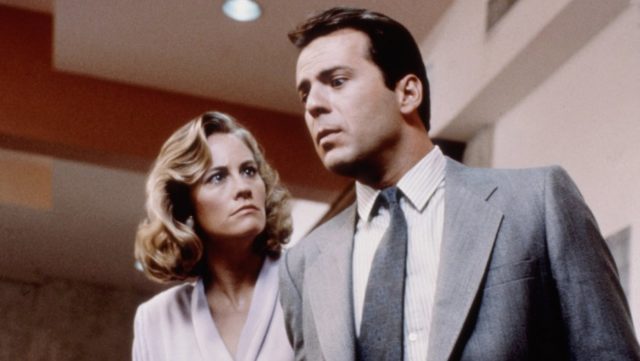
These choices are based on unique categories created just for this blog. The reason is actually pretty simple. The mystery category is really a crossover category. It can include shows that were suspense, thrillers, or even a romantic comedy (yes, there is one on the list). The crossover quality makes the number of choices quite maddening. So I created my own categories.
Another problem is the “all-time” label. There should be an all-time list, but sometimes a mystery is great because of the writing, other times the acting, and still other times the directing can be credited to its success. The list is hardly definitive but it might be a starting point to bring some clarity and recognition to the best mysteries that ever pixelated our screens. The all-time list needs to be more specific in order to give recognition to the many variations on the basic mystery genre that have been created over the last 50 years.
The numbers are just there for organizational and reference purposes.
1. Moonlighting — best romcom mystery
The Moonlighting series was a unique mix of romance, comedy, and mystery using the Blue Moon Detective Agency as the setting. Starring Bruce Willis and Cover Girl model Cybil Shephard, it was one of the first TV series where actors talked over one another during the dialogue. What kept viewers returning week after week was the romantic tension during the storyline between Willis and Shepherd. In one episode it was suggested that the two would actually be a couple — and fans went berserk. Many believed it would ruin the show because the weekly talk around the watercooler is what went on between Dave (Willis) and Maddie (Shepherd). It was actually a twofold mystery — what it would take to solve the crime and what would romantically happen between the two stars.
2. CSI: Crime Scene Investigation — best recovery for a forensic science mystery
CSI, as accepted and watched today, was lambasted it its early showing. More than a few people objected to the sexual undertones (OK, maybe overtones) and violence that were part of the mystery. It was ranked for 6 solid years as the worst primetime show by the Parents Television Council and was roundly criticized by many law enforcement agencies as overdramatic and unrealistic. But it had the advantage of opening up the murky window about forensic science to the general public. While it is true that TV reality and true reality are usually different (which makes one scratch their head about why CSI wasn’t realistic enough) its critics didn’t seem to damper its public popularity. The series hung around for 15 years and there were spinoffs that followed, as well as a video game. Far more people identify CSI as a forensic science mystery show than a blood, gory, oversexualized TV show. It took 5 years for critics to realize no TV show is perfect.
3. Alfred Hitchcock Presents — trademark directing mystery styles
When you talk mystery, the name Alfred Hitchcock must be in the conversation. His British accented, somewhat creepy “Good evening” introduction to the show is a classic memory of the TV show. Hitchcock is famously known in film for movies such as Psycho and The Birds but he also wove his way into our lives in this weekly TV series. This series ran from 1956 to 1965, during the days when color television didn’t exist and TV stations actually ended their programming by playing the national anthem. One of Hitchcock’s trademark uses of the camera to put the viewer directly into the scene by simulating the eye movements of the actor. His use of black and white in shadowing scenes is one of the most discussed directorial features.
https://www.youtube.com/watch?v=e7pHJjwzMEc
4. The Blacklist — actor drives the show’s success
James Spader, who played Raymond “Red” Reddington, has consistently been given credit for the success of the show. The storyline, an NIS officer turned fugitive turned government agent, is ideal for a TV series as The Blacklist is a list of the world’s most dangerous terrorists and criminals. The twist is that the U.S. government is not even aware of many of the names on the list. That leaves two mysteries: the names on the list and how the FBI will track them down. Critics of the show gave the series positive reviews noting that the producers found a way to maintain the storyline without diminishing the on screen presence of Spader. The public’s view was very similar to those of the critics.
5. Person of Interest — best use of a supercomputer in a mystery
The series, which aired in September 2011, could not have predicted the future of AI any better. While this supercomputer in Person of Interest was able to develop its own intelligence which was ignored by the powers-that-be, almost 6 years later the mammoth social media company Facebook would find something very similar occurring in its own systems. The TV series delved into the moral and ethical implications of the use of this new artificial intelligence, something that the public rarely considers until it has the potential to directly affect them. But the supercomputer is a mystery within a mystery, because not a lot of attention is paid to how its intelligence operates. We just know it does, and that adds a new dimension to the mystery storyline.
6. Sherlock
Sherlock Holmes is the classic British detective, having been around in one form or another since 1887. While the name is easily identifiable to mystery fans of books or film, but to keep it fresh and relevant requires more than falling back on the tried and true. To jump over this bar, actor Benedict Cumberbatch was brought in to play the lead role of Sherlock Holmes and combined with a team of writers that created new and relevant modern storylines the series has been a smashing success.
7. The Mentalist — mystery series that challenged the audience’s sense of perception
Some mysteries can get the viewer wrapped up in the “who dun it?” question of the storyline, but The Mentalist was more focused on the “how?” It both taught and tested the viewers on the clues hidden to most people that ended up being the basis for the evidence of tracking down the suspects. Instead of being a passive viewing experience, it became one where every scene has a potential clue, no matter how imperceptible it was the most viewers. The fact that the main character, Patrick jane, was also a con artist had people wondering if he was conning the other person or actually revealing a clue.
8. The Twilight Zone — futuristic, paranormal mystery
While the paranormal is a common theme in many mystery TV shows and movies, The Twilight Zone hosted by Rod Serling was the first to bring together the elements of the unexplained and the future in a single 30 minute episode. You never knew what you were going to get, and sometimes even the title of the episode was an ambiguous clue to what to expect. Even when seen today, the storylines will help you ignore the 1950’s black and white, relatively unimaginative scenery. The TV series was interesting enough to launch several remakes decades later.
9. Magnum P.I. — historic TV mystery series
You may not watch the current CBS series Blue Bloods because Tom Selleck is a GQ model, but it was a very different story in the 1980’s. Not only was Selleck’s character Thomas Magnum a sexy P.I. who drove an awesome car, he was also a former Navy Seal and Vietnam vet. These last two facts earn Magnum P.I. a spot on the list because it was the first time a Vietnam vet character was portrayed as more than cannon fodder on a TV series. In effect, he was every man’s man and every woman’s heartthrob. Though the storylines are not as scintillating as most of the others on this list, the fact that the show ran for 8 seasons is proof that it had offered the public something in a mystery show that audiences wanted.
10. Perry Mason — groundbreaking lawyer centered mystery
Think of Perry Mason as the Law and Order series of the 1960’s – without the Law. That is a pretty tall order to fill, especially when you consider that it was the first hour long TV series to air. Raymond Burr played the lead role, with a charitable dose of his P.I. to gather some evidence. Unlike today’s mysteries, Perry Mason was more formulaic in its approach, but follows the basic storyline of introducing the list of potential suspects, investigating the stories, and having the suspect eventually confess. Perry Mason had one hour to assemble the pieces, and may seem much longer to develop than its modern day counterpart, Law and Order (choose your spinoff). Being able to pull off a one hour show focusing mainly on the lawyer shows the power of the actor and the character.
11. The Rockford Files — P.I. with an attitude
Where Perry Mason was formulaic, The Rockford Files was anything but. The main character, played by James Garner, was an ex-con who was wrongly convicted, pardoned 5 years later, then becomes a P.I. living in a mobile home wearing cheap suits. He would never take on a case that was actively being investigated by the police, in part because he wanted to avoid any contact with them at all. This limitation requires Rockford to find less than conventional ways to get information. Garner would later say that his character got beat up an average of twice per 60 minute episode. Though the storylines are relatively simple, it is how the case is solved that makes all the difference here.
12. Criminal Minds — entering into the dark side
This is not a sci-fi mystery but a shift in focus from the crime and the cops who pursue the suspect to entering into the minds of serial killers. This creates a very dark and edgy type of mystery, one that goes beyond the average viewer’s ability to understand because, well, most people do not have the mind of a serial killer. This challenges the writers to go through the process of revealing the whys and motivations of the killers at a pace that will not lose the viewers but not reveal too much, too soon. The result is a TV series that is dark and oftentimes disturbing.
13. Blind Spot — best use of a woman’s body in a mystery
Even the trailer for this show makes you want to watch how the story will unravel. A naked woman is found in a Ziplock bag with tattoos all over her body, but she has no memory of anything. It is later discovered the tattoos are clues to future crimes. There are several layers of mysteries here, and while the execution of the idea has not been perfect, the number of layers and possibilities is intriguing. Who the women is, who puts the tats on her, why did the tat artist choose her, and how did she lose her memory are all multiple storylines. Then of course there are the crimes themselves. The fall season finale had fans wondering what Weller was doing in Berlin. If you need to catch up or catch on, you have until January 12th when the next episode is scheduled for viewing.
14. The Fugitive — first 4 year ongoing mystery saga
How long did it take for viewers to really understand what was going on? The 14th episode. The producers decided to keep the details of Richard Kimble’s plight secret for 13 weeks. What is amazing is that viewers were not so much concerned with the details but instead followed the show to see how Kimble would avoid being captured. His presumed innocence is a hallmark of the 4 year series, and the series ended when he finally caught up with the murderer of his wife. The 1993 movie version was excellent, and compacted 4 years into 2 hours with awesome performances by Harrison Ford and Tommy Lee Jones. The fact that we knew at the beginning that Kimble was innocent didn’t matter.
15. Miss Fisher’s Murder Mysteries — mass appeal mystery
This is in a different world than Sherlock because while Sherlock became famous because of its historical appeal, Miss Fisher’s Murder Mysteries was designed to become successful before episode one was scripted. The main character is a female, feminist, wealthier and better dressed version of James Bond. The novels had been discovered to appeal to a wide range of demographics, from teenagers to 70 year olds. So the show was designed to appeal to that mass base of fans — and it worked. Set in the 1920’s, Miss Fisher’s Murder Mysteries is a less violent, more intelligent approach to the traditional mystery-detective shows which is something that obviously appeals to young and old alike.
16. Twin Peaks — artful mystery
Twin Peaks actually stumbles on to this list, in part because the series has been splintered and is separated by a decade from its first episode to its current airing. Despite the unfortunate decisions by network executives, the show has been critically acclaimed for its method of storytelling and attention to detail that defined its very unconventional approach to the TV mystery genre. It was this very unconventional approach that had critics originally saying the show had zero chance of success. Perhaps it needed to be moved away from the more staid standards of network television and be freed up to cable networking. Its resurgence on Showtime has critics noticing it once again, and while there is no “good guy” viewers can root for, its unusual style and offbeat appeal continues to attract viewers.
17. Columbo — invert the storyline
Most mysteries have the “who dun it?” characteristic, where a crime is committed and the viewer is asked to follow the breadcrumb trail to discover who the culprit is. Writers of the Columbo show inverted the approach and let you know who did it at the beginning. The question changed the focus from the criminal to the detective and how he would catch the bad guy. Columbo, played by Peter Falk, had a “one more thing” question that often would be the trap to end the episode. It really is worth a watch if you are tired of the same old, same old type of mystery.
18. Supernatural — invert the focus of the storyline
There is a long history behind how the Supernatural series came to be, but its existence on this list is largely in part due to the two lead actors, Jared Padalecki and Jensen Ackles. The original focus was to be on the supernatural beasties that would come out and scare people. But after a few episodes (give kudos to the writers and producers) it was noticed that there was a unique personal chemistry between Padalecki and Ackles, so the focus was changed to the relationship between the two brothers. It inspired a number of spinoffs, and moved the bar higher to make mysteries surrounding supernatural events and forces to be more character focused.
19. Designated Survivor — modern and relevant political mystery
The new ABC series stars Kiefer Sutherland of “24” fame and just watching the trailer has you wondering just how the rest of the series will play out. It deals with very relevant political topics of the day combined with President Kirkman’s (Sutherland) ongoing dilemma about how he will manage to stay in office with threats coming from inside and outside the White House trying to oust him from the position. Some call this a drama, but the actual storyline is a mystery on not only how Kirkman will manage to solve the constant Gordian Knot’s he is faced with from day to day, but how he will manage to stay in office. For example, in the season finale Kirkman’s wife gets killed in a car accident, but it is not clear whether it is accidental or deliberate. That leaves the door open for the “who dun it?” storyline next season.
20. House — a medical mystery
Unlike the forensic science genre of medical mystery shows, the mystery in House is just how lead character Gregory House played by Hugh Laurie will react to any specific situation. The medical diagnoses are often proven wrong by his associates, and often it answer to a patient’s dire medical situation is some obscure or easily overlooked piece of knowledge. The mystery is in the maze of evidence that is presented, much of it making sense as the show progresses. But it is the character of House, who is addicted to pain killers and will conflict with virtually anyone in his quest to cure the patient that makes this show more than just a drama. The actual mystery is for the viewer to try and understand what actually drives House.
If you are going to complain about some of the categories or who made the list, that’s fine because after doing the basic research on this list I discovered everyone seems to be afraid of doing more than just copying and pasting from other website’s lists. Aside from that whining, it also is that sometimes drama and mystery cross over, and just who decided on these categories anyway? There are a number of innovators of the mystery genre in this list, and for good reason. The reality is that viewers embrace change, whether it was in 2016 with Blind Spot or Moonlighting in 1985.
 Follow Us
Follow Us





